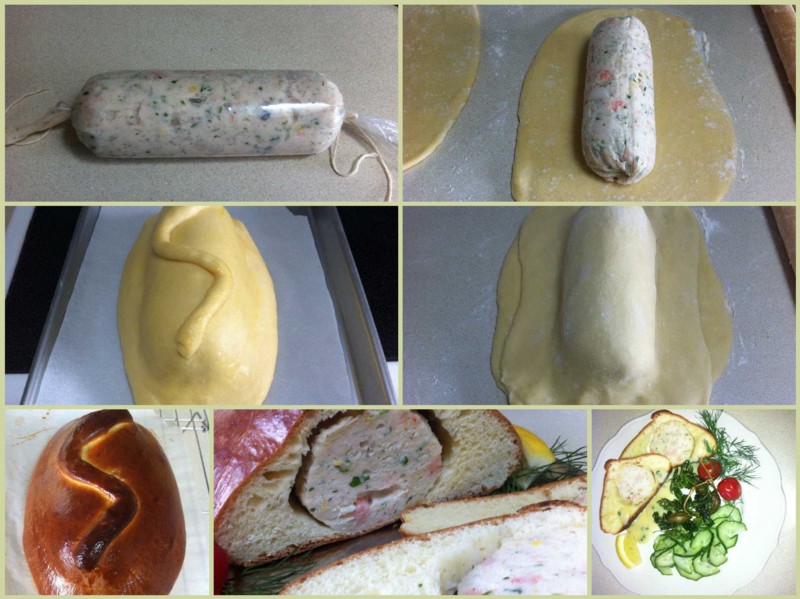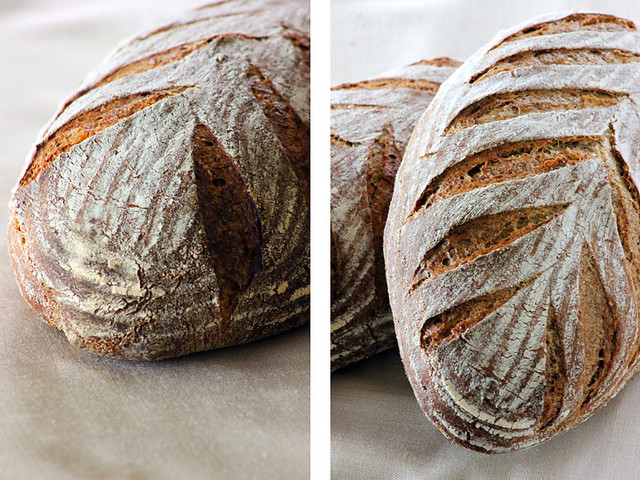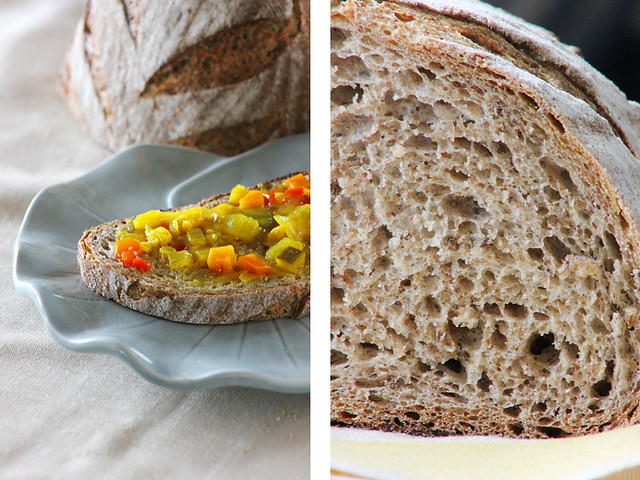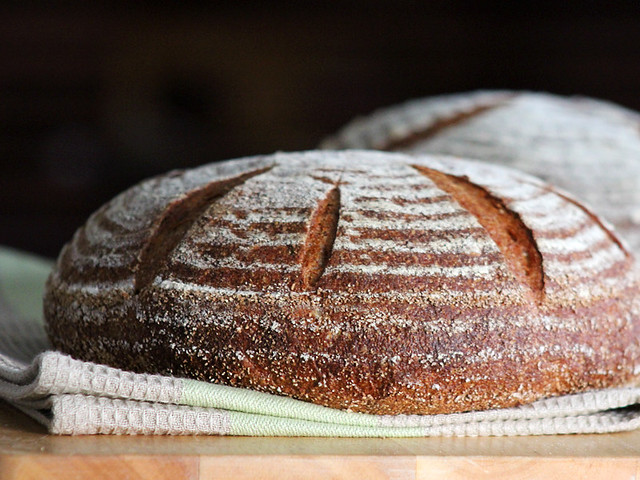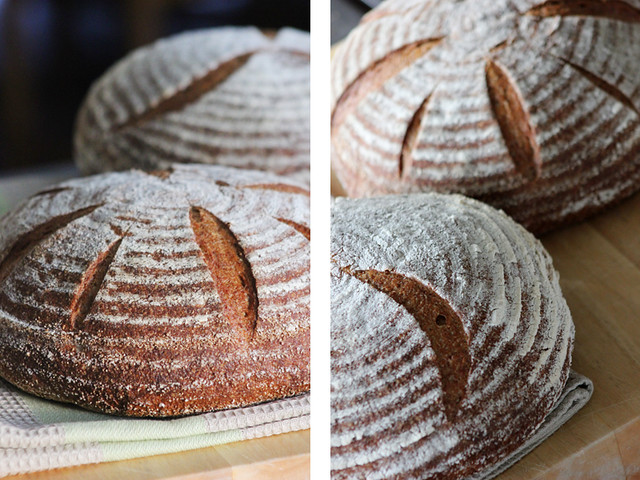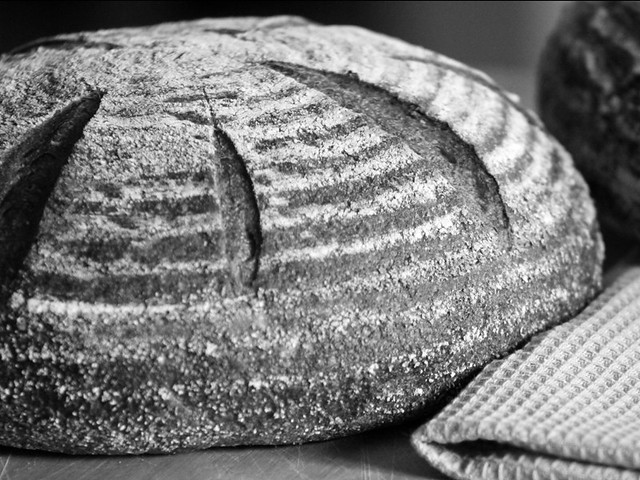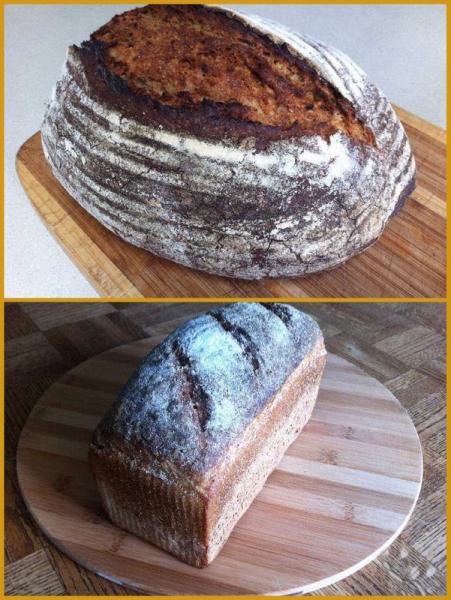
Back In early May I posted on a 40% Rye http://www.thefreshloaf.com/node/28620/goo-good with a fermented soaker that I had to try and save because of miscalculating the hydration. The save was short lived unfortunately. After three days the crust became so tough from the extra flour added to the dough I couldn't eat it for fear of cracking a tooth. The formula has since been adjusted for hydration and two bakes of the bread have been done over the last few weeks with much better results than the original. The first loaf of the new mix worked out well, the dough consistency being what I expected, well hydrated but not to such an extent it was difficult to develop with a few stretch and folds. This time instead of baking it in a Pullman tin, the dough was shaped as a batard and placed in a brotform. The bread was to be part of a buffet table at my wife Marie's recent birthday party and I wanted it to look a little fancier than a regular tinned loaf. The loaf baked up nicely with a cracking crust, evenly open crumb, and well rounded flavour with a pleasant sour note from the soaker.
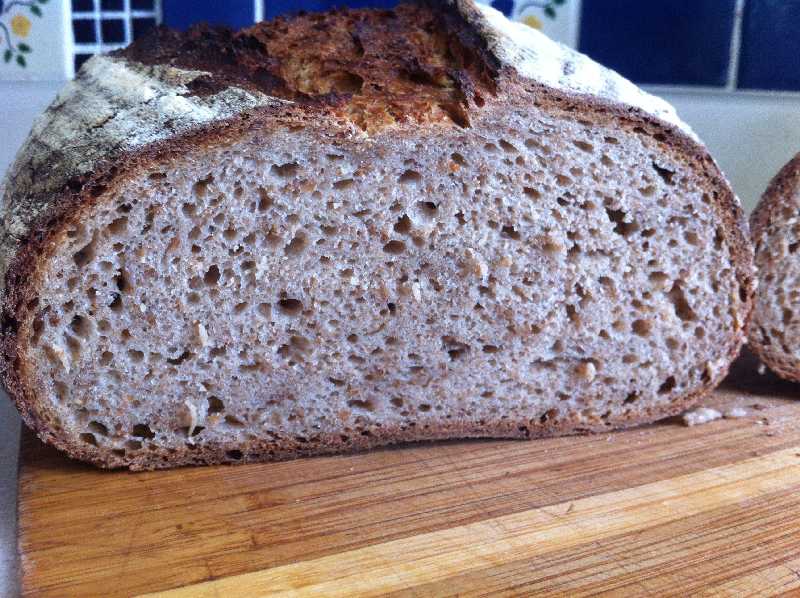
One of our guests told me that she's usually not a fan of either rye bread or sourdoughs but that she enjoyed the flavour and texture of this bread more than any she'd had in the past. This was reassuring to hear and good to know that other people could enjoy it since to that point I'd been the only who'd tasted it.
Last week we took a mini 3 day vacation out to the West Coast of Vancouver Island for a little R&R. On our way out to the coast we made a stop at Vancouver Island Grain and Milling, in the city of Port Alberni. VI Grain & Milling, a relatively new enterprise, came to my attention when Marie brought home one of their pamphlets from a local Farmer's Market. The proprietor, Wayne Smith runs the facility on his home and farm property located just a short drive from the main highway through town. At the moment the various organic grains he carries are kept in three, temperature and humidity controlled semi trailers situated near the front entrance of his property, with construction of a permanent storage facility getting under way this summer. One of the trailers has a small milling area equipped with four Nutrimills that he uses to produce retail size (2K) bags of flour for a number of health food stores here on the Island.

Wayne told me he doesn't anticipate installing a full size mill anytime soon as the investment cost and profit margin wouldn’t justify it at this point in the business, but that he'd be happy to mill whatever I needed on short notice. What a find! I asked him if he would mill up a slightly coarse rye flour for me while I was there, and a short time later Wayne presented me with 2 kilos of the best looking rye flour I think I've ever seen.
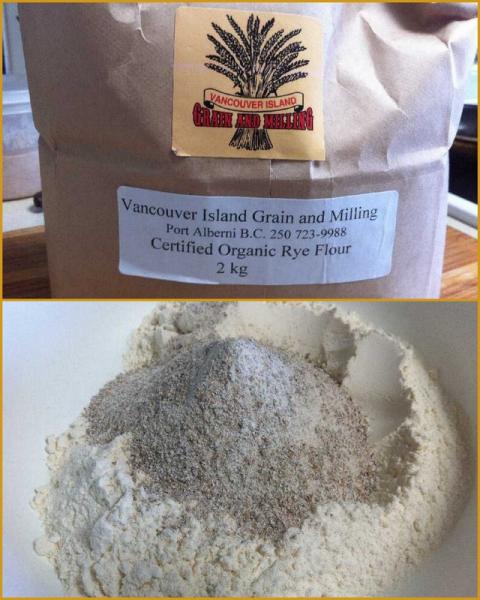
This is the flour I used in a second bake of the 40% rye. It preformed beautifully throughout the mixing, fermentation, shaping and baking, giving the bread an even better depth of flavour than the previous bake. The fermentation properties and flavour of fresh milled flour compared to pre-milled is so superior, I'm finally persuaded to invest in a flour mill for my home baking. Much as I'd prefer a stone mill similar to the type [Phil/Pips] uses, I've decided the size and cost of the impact type Nutrimill is a better fit for my storage and budget limitations right now. Once the existing stock of wheat and rye flour I already have has been used up I'll be looking forward to milling all my own flour with grains from Wayne Smith's VI Grain & Milling.
The second bake of the 40% Rye was slightly different in that the soaker was all cracked rye instead of 50/50 cracked rye and wheat, but other than that the rest of the formula remained the same as per the previous mix. Since I've started using a fermented soaker in some of my sourdoughs I've discovered how much easier it is to fine tune the level of sour in the loaf, rather than having to rely entirely on the levain to contribute the bread's sour component. Cracked or whole grains ferment quite slowly compared to flour, allowing for greater control over the strength of the sour flavour than I feel I have with a typical 12-18 hour levain. With the soaked grains adding texture to the loaf along with added flavour, it's proven to me to be an effective technique for enhancing the overall quality of the finished loaf.
After pulling the loaf from the oven, de-panning, and wrapping in linen, it was left to cool for 48 hours. This was difficult! I was tempted to take a slice the day after baking but I'm glad I gave it one more day. The crumb, after 48 hours had set completely, allowing for clean even slices to be taken, minus the usual residue left on the knife when I slice a rye bread after only 24 hours.


40% Rye with Fermented Soaker
Procedure:
Levain
Mix all of the flour needed for the levan with mature 100% rye starter and water and ripen at 70F/21C for 14-18 hours.
Cracked Rye and Wheat Soaker
Pour the boiling water over the two cracked grains and salt and allow to cool to ambient temperature. Add the mature 100% rye starter, mix thoroughly and ferment at 70F/21C for anywhere from 3-5 days depending on the level of sour flavour desired. Note: The amount of water needed may need to be adjusted to achieve a slightly loose consistency. The soaker is not hydration nuetral and should contribute a small amount of hydration to the final mix.
Final Mix (by hand)
Combine all the flour and water to a shaggy mass, adjusting for hydration, and autolyse for 40-60 minutes. Add the levan and incorporate thoroughly, then add the salt and honey and mix until the dough is moderately developed. Finally add the fermented soaker and continue mixing until the soaker is evenly distibuted throughout the mix. Turn the dough onto the table and use the slap and fold method until the dough is smooth and cohesive but not fully developed. DDT is 78F/25C.
Bulk ferment the dough for 60-90minutes at 78F/25C. Bulk fermentation times will vary and the dough should be monitored closley to ensure it receives adequate fermentation time.
Intermediate
Turn the dough onto the table and give it a stretch and fold. Cover the dough and rest it for 30 minutes. Shape as desired.
Final Proof and Bake
After shaping, give the dough it's final rise in a covered 78F/25C slightly moist environment for 45-60 minutes. Again it should be closely monitored, as times will vary. When the dough is slightly springy to the touch remove it from final proof to the counter allowing the skin to dry if necessary before slashing. Slash as desired and bake in a 500F/260 oven, vents blocked, with steaming apparatus in place, for 15 minutes. Unblock the vent, remove the steaming apparatus and lower the temperature to 465F/240C, continuing the bake for an additionl 45-55 minutes (lowering the temperature if needed to 450F/232C) until the internal temperature reaches 210F/98.8 . Cool on a rack for 24-48 hours, wrapped in linen, before slicing.
The flavour is noticeably better than the previous bake, which I credit to the fresh milled rye flour from V.I. Grain & Milling used in the mix and certainly one the best flours I've had the pleasure of working with.
Cheers,
Franko










